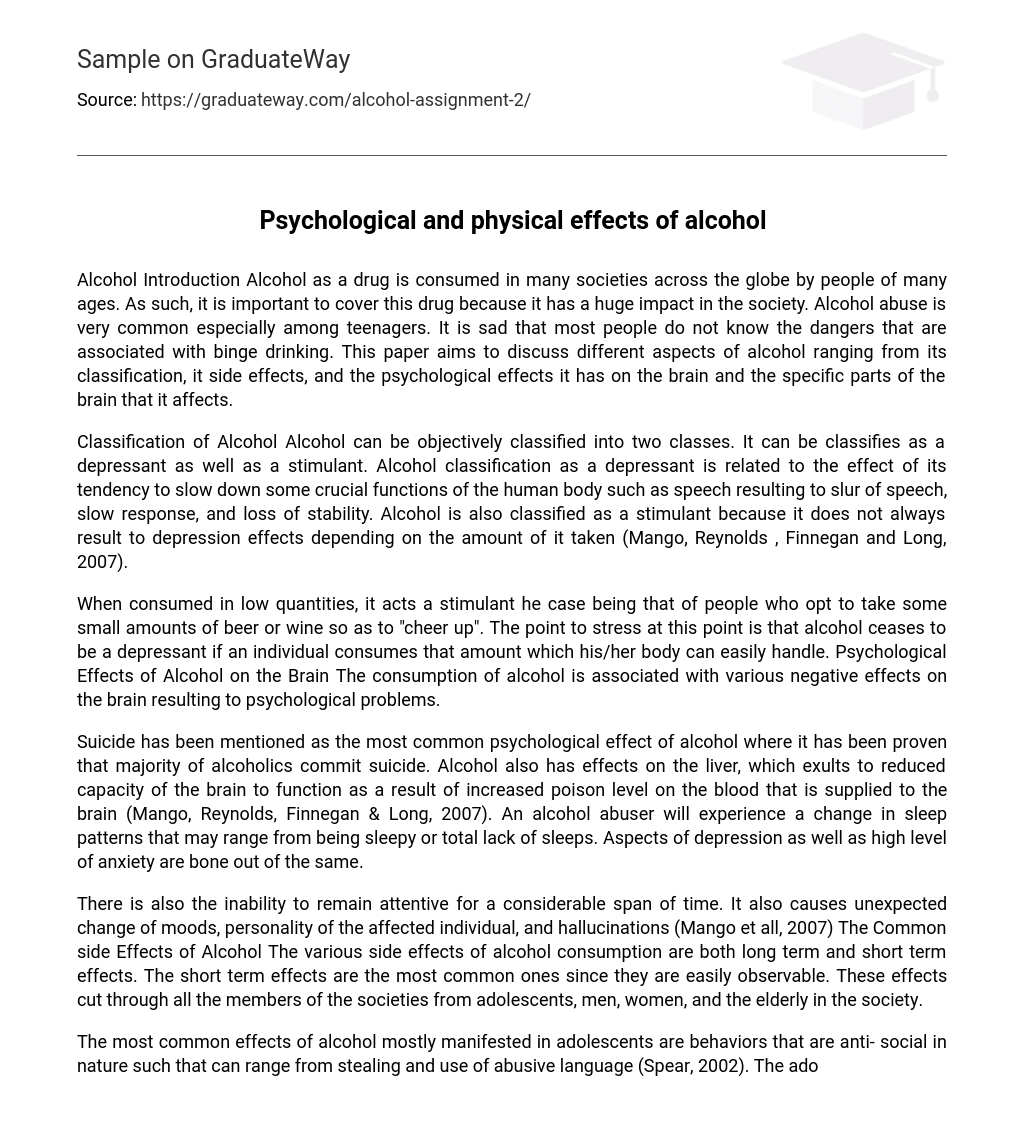Alcohol Introduction Alcohol as a drug is consumed in many societies across the globe by people of many ages. As such, it is important to cover this drug because it has a huge impact in the society. Alcohol abuse is very common especially among teenagers. It is sad that most people do not know the dangers that are associated with binge drinking. This paper aims to discuss different aspects of alcohol ranging from its classification, it side effects, and the psychological effects it has on the brain and the specific parts of the brain that it affects.
Classification of Alcohol Alcohol can be objectively classified into two classes. It can be classifies as a depressant as well as a stimulant. Alcohol classification as a depressant is related to the effect of its tendency to slow down some crucial functions of the human body such as speech resulting to slur of speech, slow response, and loss of stability. Alcohol is also classified as a stimulant because it does not always result to depression effects depending on the amount of it taken (Mango, Reynolds , Finnegan and Long, 2007).
When consumed in low quantities, it acts a stimulant he case being that of people who opt to take some small amounts of beer or wine so as to “cheer up”. The point to stress at this point is that alcohol ceases to be a depressant if an individual consumes that amount which his/her body can easily handle. Psychological Effects of Alcohol on the Brain The consumption of alcohol is associated with various negative effects on the brain resulting to psychological problems.
Suicide has been mentioned as the most common psychological effect of alcohol where it has been proven that majority of alcoholics commit suicide. Alcohol also has effects on the liver, which exults to reduced capacity of the brain to function as a result of increased poison level on the blood that is supplied to the brain (Mango, Reynolds, Finnegan & Long, 2007). An alcohol abuser will experience a change in sleep patterns that may range from being sleepy or total lack of sleeps. Aspects of depression as well as high level of anxiety are bone out of the same.
There is also the inability to remain attentive for a considerable span of time. It also causes unexpected change of moods, personality of the affected individual, and hallucinations (Mango et all, 2007) The Common side Effects of Alcohol The various side effects of alcohol consumption are both long term and short term effects. The short term effects are the most common ones since they are easily observable. These effects cut through all the members of the societies from adolescents, men, women, and the elderly in the society.
The most common effects of alcohol mostly manifested in adolescents are behaviors that are anti- social in nature such that can range from stealing and use of abusive language (Spear, 2002). The adolescents will also tent to be very violent (Shoehorn, 2004). This violence does not only apply to adolescents alone. Other effects that are in a majority of alcohol takers are accidents associated with fires, car crashing, and collisions and generally accidental falls in places such as bath rooms. This is especially the case among the elderly persons whose ability to handle alcohol is very minimal.
Irresponsible sexually behavior among the adolescents and women is another common effect of alcoholism the result of which is increased exposure to unwanted pregnancies as well as exposure to sexually transmitted diseases. Other effects are inability to maintain good relationships with other members of the society. As mentioned before, alcohol also results to depressed speech, loss of stability and some mental problems resulting to increased stress levels (Mango et all, 2007) Brain Target and Alcohol Effect on Neurotransmitter Glycerin receptors of the brain are the common target of the brain.
This is supported by the evidence that alcohol has much profound effects on the thinking capacity of an individual, moods, and generally his/her behavior. These functions are only achieved when there is a proper balance between of chemical types that are identifies as neurotransmitters (Barman, & Enharmonic, 2003). Whenever there is an imbalance in this chemical as a result of high toxic level of the blood supplied to the brain the ability to think is affected as well as a shift in moods and the individual behavior.
Alcohol is both an antagonist and agonies. As an antagonist alcohol reduces some effects of the neurotransmitters while as an agonies it increases the effect of some neurotransmitters (Barman, & Enharmonic, 2003). As an antagonist alcohol reduces the effects of glutamate which results to effects such as slur in speech, loss of memory and slackness in walking. Agonies effects are seen in instances where alcohol acts as painkillers, increased feeling of relaxation and generally feeling drowsy.
Conclusion It is evident from the discussion that alcohol is a depressant and stimulant drug depending on the amount consumed on desired aspect on an individual. Alcohol affects different people in the society from young people to the adults. Furthermore, it has been established that alcohol has both psychological and physical effects, the physical effects mostly easily identified. Alcohol affects the functioning of the liver and as such the effect is transmitted to the brain and costly affects the glycerin receptors of the brain.





